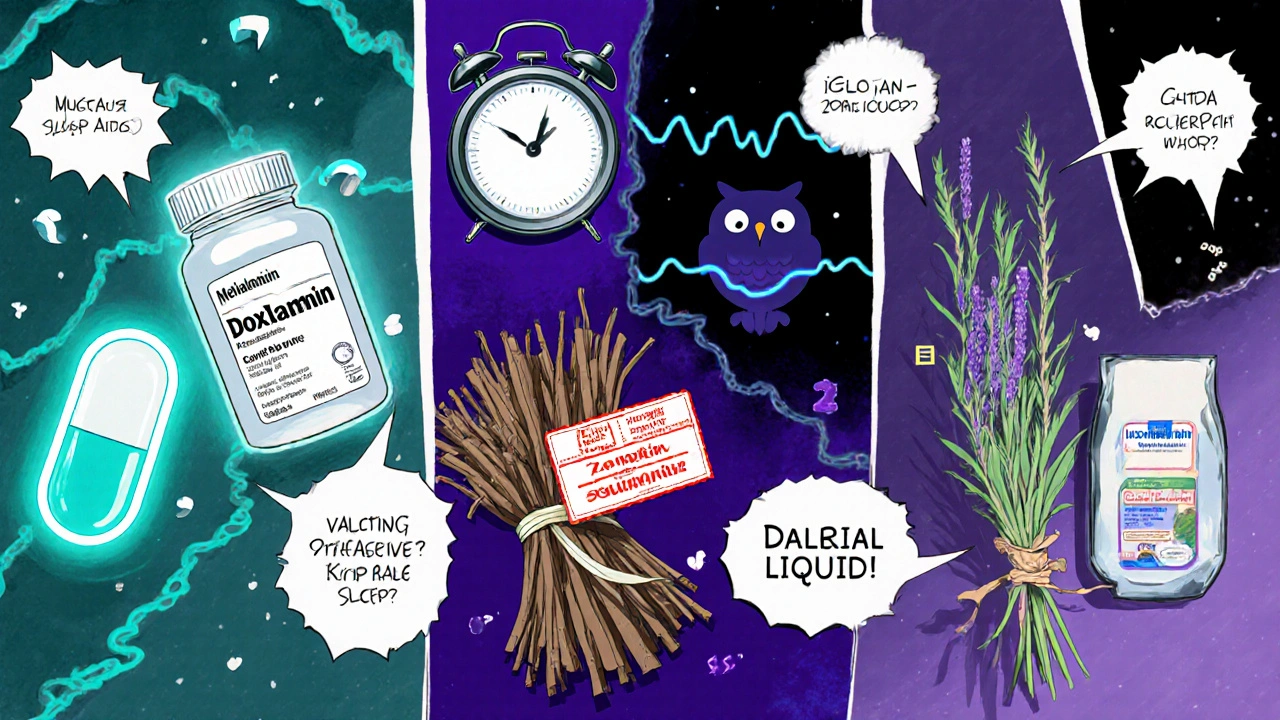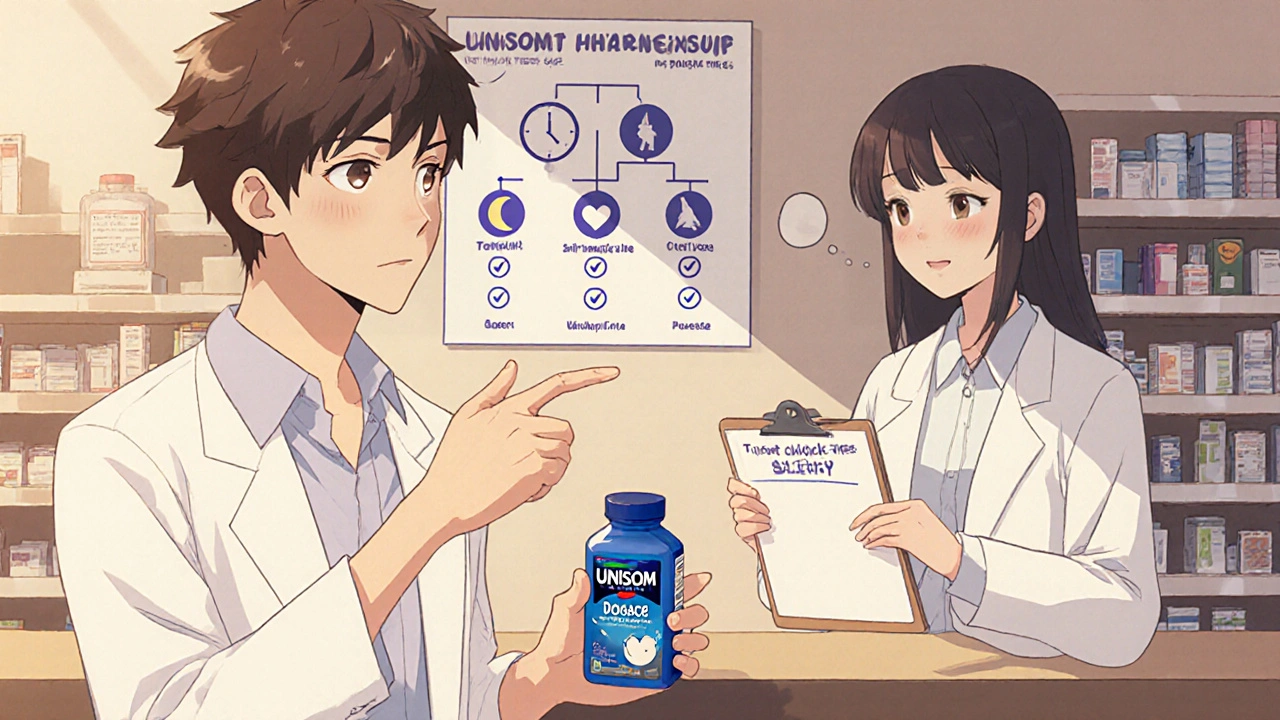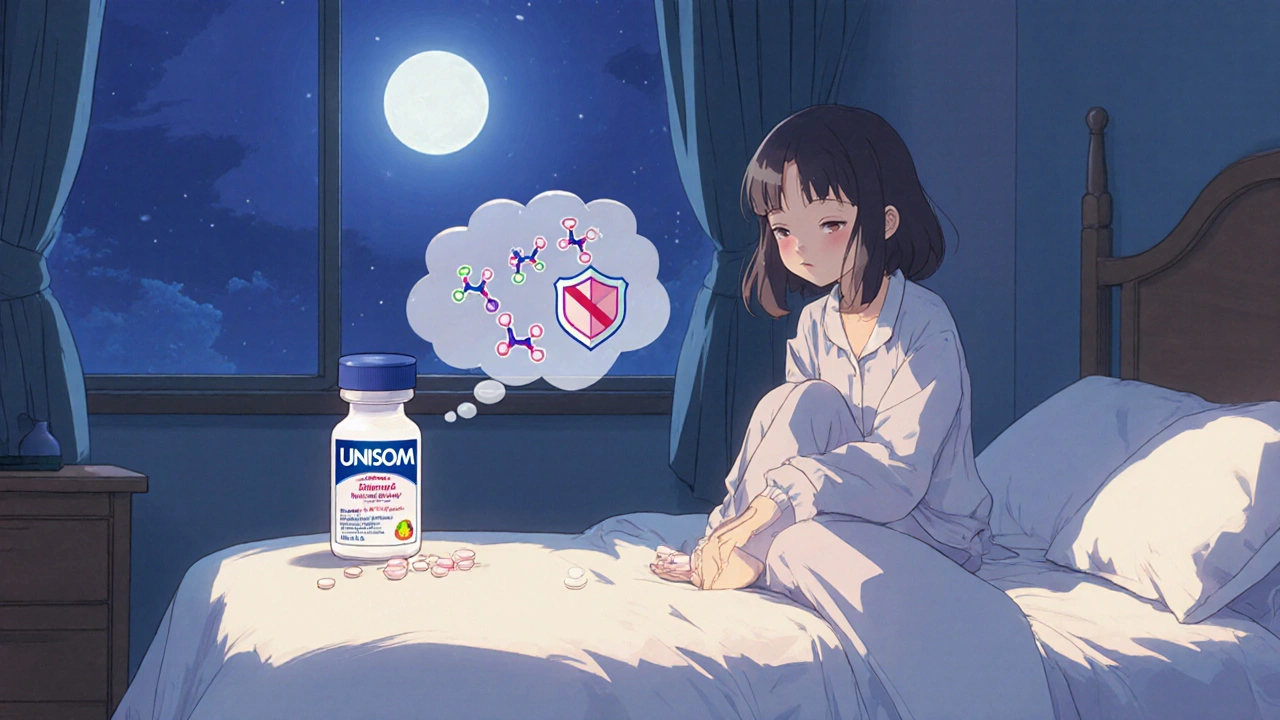Sleep Aid Selector Tool
Select Your Sleep Aid Profile
Recommended Sleep Aid
Quick Takeaways
- Unisom’s active ingredient, diphenhydramine, works by blocking histamine receptors and causing drowsiness.
- Melatonin is a hormone‑based aid that helps reset the body’s sleep‑wake clock, ideal for shift workers.
- Doxylamine is another antihistamine with a longer half‑life, often better for people who need all‑night coverage.
- Zolpidem is a prescription‑only hypnotic that acts on GABA receptors, offering rapid onset but requiring doctor supervision.
- Valerian root and other herbal options provide mild sedation with fewer next‑day grogginess issues.
Unisom is a brand name for diphenhydramine, an over‑the‑counter (OTC) antihistamine commonly used as a short‑term sleep aid. It was first marketed in the 1970s and remains a go‑to option for occasional insomnia because it is inexpensive and widely available.
How Unisom (Diphenhydramine) Works
Diphenhydramine blocks H1 histamine receptors in the central nervous system (CNS). Histamine normally promotes wakefulness, so when you inhibit its action, you feel drowsy. The drug also has anticholinergic properties, meaning it can dry up secretions and cause mild confusion at higher doses.
The typical adult dose is 25-50 mg taken 30 minutes before bedtime. Its onset is usually 15-30 minutes, with a half‑life of about 4-8 hours, which explains why some users experience a “hangover” feeling in the morning.
Key Alternatives to Unisom
Below is a snapshot of five common alternatives. Each has a distinct mechanism, onset time, and safety profile.
Melatonin is a naturally occurring hormone that regulates the circadian rhythm. Supplemental melatonin mimics the body’s own signal to prepare for sleep, making it popular for jet lag and shift‑work disorders.
Doxylamine is another first‑generation antihistamine, found in products like NyQuil. It has a longer half‑life (10-12 hours) and often provides more sustained sleep than diphenhydramine.
Zolpidem (brand name Ambien) is a prescription hypnotic that binds to the GABA‑A receptor complex, enhancing the inhibitory neurotransmitter GABA. It delivers fast onset (within 15 minutes) and short duration, but requires a doctor’s approval due to dependence risk.
Valerian root is an herbal extract used for centuries in Europe. Its active compounds, valerenic acid and volatile oils, modulate GABA receptors, offering gentle sedation without the strong anticholinergic side‑effects of antihistamines.
Benadryl is the generic name for diphenhydramine sold as a liquid or chewable tablet, primarily marketed for allergy relief. Because it contains the same active ingredient as Unisom, its sleep‑inducing effects are comparable, but dosing may differ.

Side‑Effect Profiles at a Glance
Understanding potential adverse reactions helps you pick the safest option for your situation.
- Unisom/Diphenhydramine: dry mouth, blurry vision, urinary retention, next‑day drowsiness.
- Melatonin: vivid dreams, occasional morning grogginess, rare headache.
- Doxylamine: stronger anticholinergic effects, higher likelihood of next‑day sedation.
- Zolpidem: risk of complex sleep‑related behaviors (e.g., sleep‑walking), dependence with prolonged use.
- Valerian root: mild stomach upset, possible headache; generally low toxicity.
Comparison Table
| Ingredient | Mechanism | Typical Dose (Adults) | Onset | Duration | Key Side‑Effects | OTC / Prescription |
|---|---|---|---|---|---|---|
| Diphenhydramine (Unisom) | H1 antihistamine | 25-50 mg | 15-30 min | 4-8 h | Dry mouth, next‑day grogginess | OTC |
| Melatonin | Hormone supplement (circadian regulation) | 0.5-5 mg | 30-60 min | 5-7 h | Vivid dreams, mild headache | OTC |
| Doxylamine | H1 antihistamine | 12.5-25 mg | 15-30 min | 8-12 h | Strong anticholinergic effects | OTC (in combo products) |
| Zolpidem | GABA‑A agonist | 5-10 mg | ~15 min | 3-6 h | Sleep‑walking, dependence | Prescription |
| Valerian root | Herbal GABA modulator | 400-900 mg | 30-60 min | 4-6 h | Stomach upset, mild headache | OTC |
Choosing the Right Option for You
Consider these decision factors before reaching for the night‑stand bottle.
- Frequency of Use: If you need a sleep aid less than twice a week, an OTC antihistamine like Unisom or Doxylamine is acceptable. Daily use pushes you toward melatonin or a prescription under doctor supervision.
- Side‑Effect Tolerance: People with dry‑eye conditions, glaucoma, or urinary retention should avoid diphenhydramine and opt for melatonin or valerian.
- Age and Health Status: Children under 12 should not use diphenhydramine for sleep. Seniors are more prone to anticholinergic side‑effects, so melatonin or low‑dose valerian is safer.
- Drug Interactions: Diphenhydramine can amplify the sedative impact of alcohol, benzodiazepines, or other CNS depressants. Zolpidem has strict contraindications with certain antidepressants.
- Regulatory Oversight: The FDA classifies diphenhydramine as a safe OTC medicine when used as directed. Prescription drugs like zolpidem undergo stricter monitoring due to abuse potential.

Safe Use Guidelines for Unisom
- Never exceed 50 mg in a 24‑hour period.
- Avoid alcohol or other sedatives within 4 hours of taking the dose.
- Do not operate heavy machinery the next morning if you feel groggy.
- If you have chronic insomnia, limit use to short bursts (max 2 weeks) and consult a healthcare professional.
- Store the product in a cool, dry place and keep out of reach of children.
Common Pitfalls and Pro Tips
Even a simple sleep aid can backfire if you ignore a few practical tips.
- Timing Mistake: Taking Unisom too early can lead to waking up mid‑night; aim for 30 minutes before lights‑out.
- Mixing Antihistamines: Using both Unisom and an allergy medication containing diphenhydramine doubles the dose unintentionally.
- Relying on It Every Night: Your body can develop tolerance, making the pill less effective and prompting higher doses.
- Ignoring Underlying Causes: Stress, caffeine, or irregular bedtime routines often cause sleeplessness more than a chemical deficit.
- Travel Hacks: For jet lag, combine a low‑dose melatonin with a short‑acting antihistamine on the first night to reset the clock faster.
Frequently Asked Questions
Can I use Unisom every night?
Occasional use (no more than twice a week) is generally safe for healthy adults. Daily use can cause tolerance, next‑day drowsiness, and anticholinergic buildup, so it’s best to seek a longer‑term solution if insomnia persists.
Is melatonin better for shift workers than Unisom?
Melatonin aligns the body’s internal clock, making it a preferred choice for irregular schedules. Unisom can still help fall asleep, but it does not adjust circadian rhythm, so melatonin often yields smoother transitions.
What’s the biggest safety concern with diphenhydramine?
Anticholinergic effects-dry mouth, blurred vision, constipation, and especially confusion in older adults-are the main worry. High doses can also cause cardiac arrhythmias.
Can I combine valerian root with Unisom?
Both act as sedatives, so stacking them may increase drowsiness excessively. If you need stronger sleep, talk to a doctor rather than mixing OTC agents.
Is Unisom safe for pregnant women?
Diphenhydramine is classified as Category B by the FDA, meaning animal studies show no risk but human data are limited. Pregnant individuals should consult their obstetrician before using any sleep aid.
Choosing the right sleep aid hinges on your health profile, how often you need help, and whether you can tolerate anticholinergic side‑effects. Unisom offers a cheap, accessible option for occasional use, but alternatives like melatonin, doxylamine, or prescription‑only zolpidem may fit better for chronic insomnia or specific timing needs. Always read labels, respect dosing limits, and consider a brief discussion with a pharmacist or doctor if you’re unsure.


Author
Mike Clayton
As a pharmaceutical expert, I am passionate about researching and developing new medications to improve people's lives. With my extensive knowledge in the field, I enjoy writing articles and sharing insights on various diseases and their treatments. My goal is to educate the public on the importance of understanding the medications they take and how they can contribute to their overall well-being. I am constantly striving to stay up-to-date with the latest advancements in pharmaceuticals and share that knowledge with others. Through my writing, I hope to bridge the gap between science and the general public, making complex topics more accessible and easy to understand.